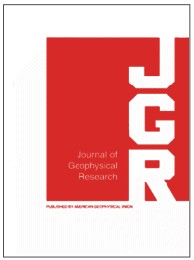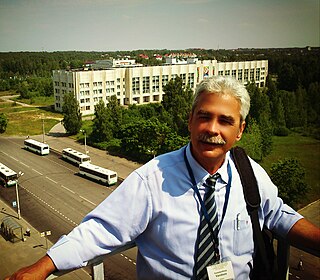
The American Geophysical Union (AGU) is a 501(c)(3) nonprofit organization of Earth, atmospheric, ocean, hydrologic, space, and planetary scientists and enthusiasts that according to their website includes 130,000 people. AGU's activities are focused on the organization and dissemination of scientific information in the interdisciplinary and international fields within the Earth and space sciences. The geophysical sciences involve four fundamental areas: atmospheric and ocean sciences; solid-Earth sciences; hydrologic sciences; and space sciences. The organization's headquarters is located on Florida Avenue in Washington, D.C.

The San Andreas Fault Observatory at Depth (SAFOD) is a research project that began in 2002 aimed at collecting geological data about the San Andreas Fault for the purpose of predicting and analyzing future earthquakes. The site consists of a 2.2 km pilot hole and a 3.2 km main hole. Drilling operations ceased in 2007. Located near the town of Parkfield, California, the project has installed geophone sensors and GPS clocks in a borehole that cuts directly through the fault. This data, along with samples collected during drilling, could shed new light on geochemical and mechanical properties around the fault zone.

Cluster II is a space mission of the European Space Agency, with NASA participation, to study the Earth's magnetosphere over the course of nearly two solar cycles. The mission is composed of four identical spacecraft flying in a tetrahedral formation. As a replacement for the original Cluster spacecraft which were lost in a launch failure in 1996, the four Cluster II spacecraft were successfully launched in pairs in July and August 2000 onboard two Soyuz-Fregat rockets from Baikonur, Kazakhstan. In February 2011, Cluster II celebrated 10 years of successful scientific operations in space. In February 2021, Cluster II celebrated 20 years of successful scientific operations in space. As of March 2023, its mission has been extended until September 2024. The China National Space Administration/ESA Double Star mission operated alongside Cluster II from 2004 to 2007.

The Journal of Geophysical Research is a peer-reviewed scientific journal. It is the flagship journal of the American Geophysical Union. It contains original research on the physical, chemical, and biological processes that contribute to the understanding of the Earth, Sun, and Solar System. It has seven sections: A, B, C (Oceans), D (Atmospheres), E (Planets), F, and G (Biogeosciences). All current and back issues are available online for subscribers.

Eos is the news magazine published by the American Geophysical Union (AGU). The magazine publishes news and opinions relevant to the Earth and space sciences, as well as in-depth features on current research and on the relationship of geoscience to social and political questions. Eos is published online daily, and as an AGU member benefit in 11 issues a year. It accepts both display and classified advertising.

Andrew Emory Dessler is a climate scientist. He is Professor of Atmospheric Sciences and holder of the Reta A. Haynes Chair in Geoscience at Texas A&M University. He is also the Director of the Texas Center for Climate Studies. His research subject areas include climate impacts, global climate physics, atmospheric chemistry, climate change and climate change policy.
Paleoceanography and Paleoclimatology is a peer-reviewed scientific journal published by the American Geophysical Union. It publishes original research articles dealing with all aspects of understanding and reconstructing Earth's past climate and environments from the Precambrian to modern analogs. Until the first of January 2018 the name of the journal was Paleoceanography.
Reviews of Geophysics is a quarterly peer-reviewed scientific journal published by Wiley-Blackwell on behalf of the American Geophysical Union. The current editor-in-chief is Fabio Florindo.

An atmospheric river (AR) is a narrow corridor or filament of concentrated moisture in the atmosphere. Other names for this phenomenon are tropical plume, tropical connection, moisture plume, water vapor surge, and cloud band.

Costas Varotsos is a Greek physicist known from his contribution to the global climate-dynamics research and remote sensing.
Sreedharan Krishnakumari Satheesh is an Indian meteorologist and a professor at the Centre for Atmospheric and Oceanic Sciences of the Indian Institute of Science (IISc). He holds the chair of the Divecha Centre for Climate Change, a centre under the umbrella of the IISc for researches on climate variability, climate change and their impact on the environment. He is known for his studies on atmospheric aerosols and is an elected fellow of all the three major Indian science academies viz. Indian Academy of Sciences Indian National Science Academy and the National Academy of Sciences, India as well as The World Academy of Sciences. The Council of Scientific and Industrial Research, the apex agency of the Government of India for scientific research, awarded him the Shanti Swarup Bhatnagar Prize for Science and Technology, one of the highest Indian science awards for his contributions to Earth, Atmosphere, Ocean and Planetary Sciences in 2009. He received the TWAS Prize of The World Academy of Sciences in 2011. In 2018, he received the Infosys Prize, one of the highest monetary awards in India that recognize excellence in science and research, for his work in the field of climate change.

Alexander J. Dessler was an American space scientist known for conceiving the term heliosphere and for founding the first Space Science Department in the United States.
Sonia Maria Kreidenweis is an American Professor of Atmospheric Sciences at Colorado State University. Her research considers aerosols and their impact on weather and the climate. She has previously served as President of the American Association for Aerosol Research and was a board member of the American Meteorological Society. She was elected a Fellow of the American Geophysical Union in 2019.
Emily V. Fischer is an atmospheric chemist and an associate professor in the department of atmospheric science at Colorado State University. She earned notoriety from her work on the WE-CAN project and on PAN, specifically its role in changing the distribution of oxidants in the troposphere. She has received many honors including the prestigious James B. Macelwane Medal which is "given annually to three to five early career scientists in recognition of their significant contributions to Earth and space science." Fischer is also a role model and activist in galvanizing support for women in STEM fields.

Nancy U. Crooker is an American physicist and professor emerita of space physics at Boston University, Massachusetts. She has made major contributions to the understanding of geomagnetism in the Earth's magnetosphere and the heliosphere, particularly through the study of interplanetary electrons and magnetic reconnection.

George L. Siscoe was an American physicist and professor emeritus of space physics at Boston University. He made major contributions to the understanding of the Earth's magnetosphere and the heliosphere, particularly in helping to establishing the field of space weather and the term heliophysics - a term which is now standard use.
Anne Ritger Douglass is atmospheric physicist known for her research on chlorinated compounds and the ozone layer.
Merri Sue Carter is an American astronomer who works at the United States Naval Observatory as director of the World Data Center for the Rotation of the Earth, Washington. She is also the author of books on the history of astronomy with her father, geodesist William E. Carter.
Oliver Holmes Gish was an American geophysicist, known for his research on atmospheric electricity and earth currents. He "contributed to our understanding of magnetic storms and the daily variation of the geomagnetic field."
Katharina Lodders is a German-American planetary scientist and cosmochemist who works as a research professor in the Department of Earth and Planetary Sciences at Washington University in St. Louis, where she co-directs the Planetary Chemistry Laboratory. Her research concerns the chemical composition of solar and stellar environments, including the atmospheres of planets, exoplanets, and brown dwarfs, and the study of the temperatures at which elements condense in stellar environments.











